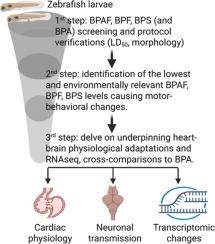低浓度双酚类似物暴露会改变斑马鱼幼体的心脑功能和转录组学。
IF 11.3
1区 环境科学与生态学
Q1 ENGINEERING, ENVIRONMENTAL
引用次数: 0
摘要
用类似物取代双酚A (BPA)可以减轻对环境的危害。通过模拟水污染并使用斑马鱼幼虫,我们验证了与BPA相比,低环境相关浓度的BPS、BPF和BPAF会引起生理和分子修饰的假设。我们使用符合经合组织的协议验证了致死剂量(LD₅₀;BPAF > BPF > BPA >; BPS),并报告在受精后5天(dpf)没有形态和肌肉异常,以及在LD₅₀以下孵化延迟。我们确定了最低双酚暴露水平会引起最显著的运动游泳变化(100 ng/L BPS, 10 ng/L BPF, 100 ng/L BPAF和100 ng/L BPA)。我们询问在低双酚水平下观察到的运动表型是否可以通过心-脑电生理适应来支持。使用体内光学定位,我们发现高频、低振幅的大脑活动增加,在BPF和BPAF的情况下,心动过缓。在这些特定的低暴露环境中,转录组学鉴定出了8个涉及心脑功能、体内平衡和免疫调节的基因,这些基因被每种双酚下调,即anxa1c、vwa10.1、zgc:172053、grna。2、ehf, gna14, ca15c, atp1a1a.5;低环境相关浓度双酚类似物改变斑马鱼幼体的器官生理和转录组。讨论了对生态毒理学和单一健康框架的影响。本文章由计算机程序翻译,如有差异,请以英文原文为准。

Bisphenol analogue exposure at low concentrations modifies heart-brain functions and transcriptomics in zebrafish larvae.
Substituting bisphenol A (BPA) with analogues could mitigate environmental harm. By mimicking water contamination and using zebrafish larvae, we tested the hypothesis that low environmentally relevant concentrations of BPS, BPF, and BPAF, compared to BPA, elicit physiological and molecular modifications. We verified lethal doses (LD₅₀; BPAF > BPF > BPA > BPS) using an OECD-compliant protocol and reported the absence of morphological and muscle abnormalities, and hatching delays below the LD₅₀ at 5 days post-fertilization (dpf). We identified the lowest bisphenol exposure levels that provoke the most significant motor-swimming changes (100 ng/L BPS, 10 ng/L BPF, 100 ng/L BPAF, and 100 ng/L BPA). We asked whether the observed motor phenotype at low bisphenol levels could be underpinned by heart-brain electrophysiological adaptations. Using in vivo optical mapping, we found increased high-frequency, low-amplitude brain activity and, in the cases of BPF and BPAF, bradycardia. Within these specific low-exposure settings, transcriptomics identified eight genes involved in heart-brain functions, homeostatic and immune regulation, that were down-regulated by each bisphenol, namely anxa1c, vwa10.1, zgc:172053, grna.2, ehf, gna14, ca15c, atp1a1a.5. Low environmentally relevant concentrations of bisphenol analogues modify organ physiology and the transcriptome in zebrafish larvae. The implications for ecotoxicology and the one-health framework are discussed.
求助全文
通过发布文献求助,成功后即可免费获取论文全文。
去求助
来源期刊

Journal of Hazardous Materials
工程技术-工程:环境
CiteScore
25.40
自引率
5.90%
发文量
3059
审稿时长
58 days
期刊介绍:
The Journal of Hazardous Materials serves as a global platform for promoting cutting-edge research in the field of Environmental Science and Engineering. Our publication features a wide range of articles, including full-length research papers, review articles, and perspectives, with the aim of enhancing our understanding of the dangers and risks associated with various materials concerning public health and the environment. It is important to note that the term "environmental contaminants" refers specifically to substances that pose hazardous effects through contamination, while excluding those that do not have such impacts on the environment or human health. Moreover, we emphasize the distinction between wastes and hazardous materials in order to provide further clarity on the scope of the journal. We have a keen interest in exploring specific compounds and microbial agents that have adverse effects on the environment.
 求助内容:
求助内容: 应助结果提醒方式:
应助结果提醒方式:


